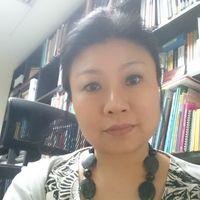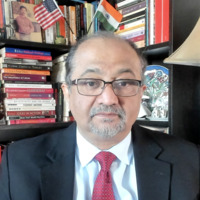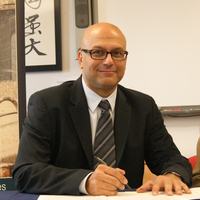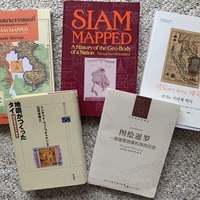
Moe Thuzar
I have two research hats: ASEAN integration issues, and Myanmar's political transition. I am also working on Burma/Myanmar's diplomatic history from 1948 to 1988 for my PhD dissertation.
less
Related Authors
Muqtedar Khan
University of Delaware
Renato De Castro
De La Salle University
Joe Maiolo
King's College London
Alistair D . B . Cook
S Rajaratnam School of International Studies
Remo Caponi
University of Cologne
Armando Marques-Guedes
UNL - New University of Lisbon
Michael W Charney
SOAS University of London
Noe Cornago
University of the Basque Country, Euskal Herriko Unibertsitatea
Narut Charoensri
Chiang Mai University
Thongchai Winichakul ธงชัย วินิจจะกูล
University of Wisconsin-Madison
InterestsView All (16)










Uploads
Papers by Moe Thuzar
The NUG’s cabinet line-up is manifestly and consciously diverse. This exhibits its intent to attract support from Myanmar’s many ethnic armed organisations. In 2021, the NUG made a series of pronouncements to display its ambition 1) to redress past injustices against various communities and ethnic nationality groups across Myanmar, and 2) to establish its legitimacy domestically and abroad. Moving forward, NUG’s great challenge lies in managing the disparate interests of the ethnic armed groups, and of regional and international interlocutors.
second mandate in the polls. In 2020 the NLD faces more critical voters than in 2015. A combination of factors has dented the NLD’s track record over the past five years, notwithstanding a few bright spots in the tackling of high-level corruption. With a returned mandate, the NLD could institute a ‘second wave’ of reforms focusing on land rights, education, healthcare, and labour law reforms, in addition to socio-economic reforms, over 2021 to 2025.
Five Union ministers are active-duty military officers, while 13 others have military backgrounds. Eight held senior posts under the 2011-2016 Union Solidarity and Development Party government, and six under the 2016-2021 National League for Democracy government. While two Union ministers are politicians, data on the backgrounds of the remaining 26 offer what amounts to a time-lapse photograph of Myanmar’s high-level government bureaucracy in recent decades, and thus make it possible to take stock of the human resources with which the SAC regime would administer the country. Unlike the civilian membership of the SAC, the junta’s roster of ministers appears intended to serve functional rather than political purposes. Scrutiny of the division of labour between the SAC junta and its Union ministers is vital to understanding the path on which Myanmar and its economy have embarked since the 1 February coup.
Civilians on the SAC include members from each of Myanmar’s eight officially designated major “national races”. Their inclusion appears to reflect a strategy of “ethnic balancing”, and the junta’s apparent approach towards collaboration with elements of Myanmar’s ethnic-nationality populations.
Its viability unclear, this strategy for buttressing the SAC’s anti-NLD project presents considerable risks both for the Tatmadaw and for Myanmar itself.
The NUG’s cabinet line-up is manifestly and consciously diverse. This exhibits its intent to attract support from Myanmar’s many ethnic armed organisations. In 2021, the NUG made a series of pronouncements to display its ambition 1) to redress past injustices against various communities and ethnic nationality groups across Myanmar, and 2) to establish its legitimacy domestically and abroad. Moving forward, NUG’s great challenge lies in managing the disparate interests of the ethnic armed groups, and of regional and international interlocutors.
second mandate in the polls. In 2020 the NLD faces more critical voters than in 2015. A combination of factors has dented the NLD’s track record over the past five years, notwithstanding a few bright spots in the tackling of high-level corruption. With a returned mandate, the NLD could institute a ‘second wave’ of reforms focusing on land rights, education, healthcare, and labour law reforms, in addition to socio-economic reforms, over 2021 to 2025.
Five Union ministers are active-duty military officers, while 13 others have military backgrounds. Eight held senior posts under the 2011-2016 Union Solidarity and Development Party government, and six under the 2016-2021 National League for Democracy government. While two Union ministers are politicians, data on the backgrounds of the remaining 26 offer what amounts to a time-lapse photograph of Myanmar’s high-level government bureaucracy in recent decades, and thus make it possible to take stock of the human resources with which the SAC regime would administer the country. Unlike the civilian membership of the SAC, the junta’s roster of ministers appears intended to serve functional rather than political purposes. Scrutiny of the division of labour between the SAC junta and its Union ministers is vital to understanding the path on which Myanmar and its economy have embarked since the 1 February coup.
Civilians on the SAC include members from each of Myanmar’s eight officially designated major “national races”. Their inclusion appears to reflect a strategy of “ethnic balancing”, and the junta’s apparent approach towards collaboration with elements of Myanmar’s ethnic-nationality populations.
Its viability unclear, this strategy for buttressing the SAC’s anti-NLD project presents considerable risks both for the Tatmadaw and for Myanmar itself.